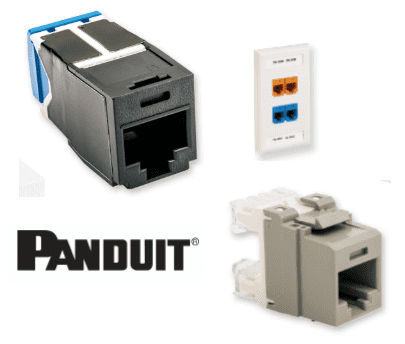Understanding connectivity when designing and deploying enterprise networks is key to achieving performance and budget objectives for any project or portfolio-wide strategy. So, let’s start at the beginning. What do we mean when we use the term “connectivity?”
Connectivity can be used in a couple of ways – the first of which is as a possessive statement or question, as in “do I have connectivity?” In this instance, the intent is to express whether or not a device, or by extension it’s user, is connected to a network or the internet. This is the complete objective of installing our second use of this term – connectivity. We deploy networks, by way of cabling and connectivity, to achieve connectivity. Fun, right?
So, let’s look as connectivity as a means to the end. When we discuss physical connectivity, we’re talking about connectors for terminating cabling, patch cords, and the various components used for permanently mounting connectors in their fixed position. Examples of copper connectivity are as follows:
- Jack modules
- Coupler modules
- Field terminable & modular plugs
- Patch panels
- Faceplates & surface mount boxes
- Patch cords
Examples of fiber optic connectivity are as follows:
- Jack modules
- Mechanical & fusion splice-on connectors (simplex & duplex style)
- MPO (miniature push-on) connectors
- Adapter panels
- Port-presentation cassettes
- Patch cords
Now that we’re on the same page about what physical connectivity consists of, let’s discuss the considerations of selecting connectivity.
No two projects are exactly alike, and each user has specific performance needs that must be balanced with their budget constraints. Sometimes the budget is right sized for a “premium” connectivity tier, such as Panduit’s Pan-Net solution. This tier of connectivity has unique termination technology that dramatically reduces common issues associated with 110-style punch down terminations, such as open contacts and pair untwist issues leading to crosstalk failures.
Premium-tier connectivity is also feature-rich compared to a more economical solution. For example, the Pan-Net tier has wide ranging options in termination panel types and sizes, faceplate types and sizes, labeling options, high-density options and color options, to name a few. When to comes to having the greatest ability to achieve desired aesthetic integration, interoperability with various systems furniture and satisfy unique project requirements, a premium tier line of connectivity will always provide the greatest benefit to the project team. That said, not every project has a budget for the premium line of connectivity. Enter the budget-friendly tier.
Projects might be budget constrained for a variety of reasons. Spaces being fit out might be temporary swing space, not justifying major expenditure. A company might be downsizing due to turbulent financial conditions. A company might be in early growth phases, straining to manage cash flow; or a company might simply not see the benefit in investing in high-performance infrastructure. Whatever the reason, having a streamlined tier of connectivity that delivers less, but costs less, has a significant role to play in enterprise networking.
Examples of streamlined features may be patch panels only offered in flat configurations, as opposed to flat and angled versions. Patch panels may only be offered in black, rather than black or white. Faceplate sizes and port configurations may be limited and as with Panduit’s NetKey line, termination technology may be simplified to 110-style, sacrificing robust features for cost savings.
Whatever the reason, project constraints should be a topic of discussion for every specifier to understand what tier of connectivity best meets the needs of the user. Likewise, every user should be educated on what they get and don’t get with their connectivity line before committing to an investment. When either a specifying consultant or a user only calls out a manufacturer by name rather than by name and tier, they leave the door open for an installing contractor to choose for them, often with limited perspective on the important issues. An installer wants to deliver a project on time and under budget, so without a detailed specification requirement to follow, most often they will default to a cheaper solution.
The point is, two tier connectivity exists for a reason – to balance performance objectives with allocated budget. If the tier of connectivity is not specified, it’s highly likely a project will end up with limited options and features, whether anyone likes it or not.
For reference, most reputable manufacturers offer two-tier connectivity solutions. This list includes (but is not limited to):
- Panduit Pan-Net (Mini-Com) vs NetKey
- Commscope Systimax vs Uniprise
- Belden RevConnect vs KeyConnect
- Ortronics Clarity (TracJack) vs TechChoice
- Leviton Atlas vs eXtreme
- Hubbell NextSpeed vs NetSelect
By keeping this information top of mind when specifying or in the case of a user, selecting your connectivity, you can best ensure the project needs will be met while minimizing unpleasant surprises during bidding and construction.
Most notably, always ensure you call out the brand and tier of at least one manufacturer by name. Of course, you can always call out each brand and manufacturer, but by at least identifying one tier, each other manufacturer is forced to match the performance called out by the lead solution, ensuring you’re getting an apples-to-apples comparison.



